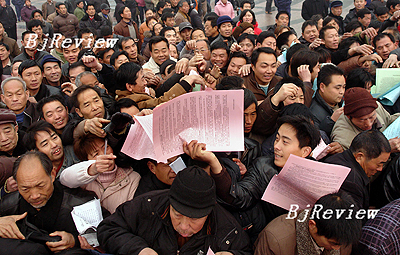
China's complex economic situation has been unprecedentedly challenged since the reform and opening-up policy adopted three decades ago. In an article published in the May 14 issue of Caijing magazine, Guo Shuqing, President of China Construction Bank, one of China's four state-owned commercial lenders, stressed that the issues of agriculture, rural areas and farmers are the biggest challenges facing the country's economic stability. Guo says only through an exceptional urbanization process can rapidly advancing social development be maintained. Excerpts:
China's development, due to its national reality, has followed a unique path. To continue its success story, policymakers are facing a bigger challenge to creatively combine the achievements of the country's previous industrialization process and an innovative growth mode.
In addition to global economic reshuffling and the new wave of sci-tech progress, China is under pressure from both industrialized economies already entering the post-industrialization age and underdeveloped nations with the "advantage of backwardness," which means they can borrow low-cost, low-risk technologies and industries from developed countries, whereas the latter need to engage in high-cost and high-risk invention to obtain technology information. Against this background, it cannot follow the conventional mode, in which the modernization processes of primary, secondary and tertiary industries are completed in sequence--instead the three industries should be equally emphasized. Or, in other words, industrialization and informationization run parallel to boost the tertiary sector.
As a result of the crawling pace of urbanization, falling far behind industrial development and the growth of gross domestic product, as well as slower-than-expected popularization of education, China's service sector, even allowing for statistical underestimates, has failed to exceed its industrial development in terms of growth speed. In fact it has not even reached the level of industrialized nations a hundred years ago. Worse still, the twin urbanization and industrialization are isolated from each other in progress.
China's urbanization has evidently lagged behind industrialization due to its unique path of industrial development through the past 50 years. Normally, industrial activities emerge first in urban or mineral-rich areas, and then stretch to suburbs or low-cost rural areas with industry transfers. However in rural China, industrialization has blossomed since the 1950s. When the reform and opening up was first felt in rural China, township and village enterprises mushroomed, but were hampered by a dual urban-rural administrative system. Disparity between different areas forced rural enterprises to seek opportunities outside of metropolises, resulting in a spatially disrupted industrial structure.
The negative impact of such decentralization in shaping a balanced economic structure and maintaining sustainable development is increasingly obvious in the past 10 years.
Given its crucial status in the national economy, agriculture demands an upgrade by taking advantage of advanced operational models. The issues of agriculture, rural areas and farmers that have challenged China for years, are essentially a matter of urbanization, without which (particularly the transfer of the agricultural population to non-agricultural sectors) a continuous income increase of farmers and agricultural modernization are baseless.
Though collectively recognized by more and more policymakers, China's urbanization needs a legal base and long-term plans to maneuver. Currently, it is imperative to find a solution to curb blind and random city expansion.
A long segregation of the urban and rural labor markets is the root cause for an unreasonable economic structure, which has dramatically reduced efficiency and the level of national welfare. A number of economists, Chinese and foreign, agreed that China's competitive advantage exists in the extreme cheap labor "guaranteed" by stagnant income levels and a deficient social security network. Nevertheless, their reasons seem unconvincing.
For example, contrary to these economists' allegations that scarce capital reserves demand big volumes of cheap labor to offset the low efficiency and high consumption for primitive accumulation, in today's China, growing net capital outflows have proved to be a complete change of its economic stance. Also, their assumption of "infinite" labor supply is fundamentally against the basic principle of economics, in addition to China's current shortage of migrant labor forces. In fact, the so-called "flexible" doctrine, which rigidly divides the labor market into urban or rural, local or migrant, and permanent or temporary categories, can only cause friction and risk, and undermine labor justice.
It's said that the segregation of urban and rural markets is effective to ensure two-way labor flows between cities and villages. People taking this stand actually disregard the inevitability of the urbanization process and their real aim is to exempt urban administrations from taking due responsibility for the protection of migrant workers. A strong economy can be achieved by hi-tech R&D and innovative competence, rather than low-cost labor. Some people have expressed the fear that better living conditions for migrant workers would accelerate the outflow of rural labor, thus threatening agricultural security. They fail to realize that the fundamental reason of the country's faltering agricultural modernization process is its ultra heavy population burden.
During the period from 1995 to 2005, China's national economy grew nearly 1.5 times, but the consumers with the most potential--tens of thousands of migrant workers--were totally ignored until the situation changed in 2005. |
